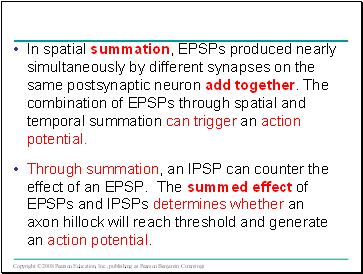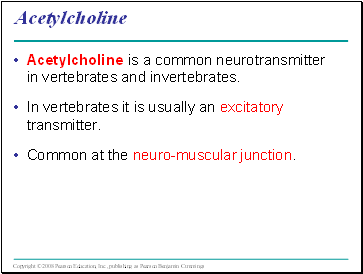Neurons, Synapses, and SignalingPage
7
7
of EPSP and IPSP
E2
E1
I
Slide 45
In spatial summation, EPSPs produced nearly simultaneously by different synapses on the same postsynaptic neuron add together. The combination of EPSPs through spatial and temporal summation can trigger an action potential.
Through summation, an IPSP can counter the effect of an EPSP. The summed effect of EPSPs and IPSPs determines whether an axon hillock will reach threshold and generate an action potential.
Slide 46
Modulated / Indirect Synaptic Transmission
In indirect synaptic transmission, a neurotransmitter binds to a receptor that is not part of an ion channel.
This binding activates a signal transduction pathway involving a second messenger in the postsynaptic cell.
Effects of indirect synaptic transmission have a slower onset but last longer.
Slide 47
Neurotransmitters
The same neurotransmitter can produce different effects in different types of cells.
There are five major classes of neurotransmitters: acetylcholine, biogenic amines, amino acids, neuropeptides, and gases.
Gases such as nitric oxide and carbon monoxide are local regulators in the PNS.
Slide 48
Slide 49
Acetylcholine
Acetylcholine is a common neurotransmitter in vertebrates and invertebrates.
In vertebrates it is usually an excitatory transmitter.
Common at the neuro-muscular junction.
Slide 50
Biogenic Amines & Amino Acids
Biogenic amines include epinephrine, norepinephrine, dopamine, and serotonin. They are active in the CNS and PNS.
Two amino acids are known to function as major neurotransmitters in the CNS: gamma-aminobutyric acid (GABA) and glutamate.
Slide 51
Neuropeptides
Several neuropeptides, relatively short chains of amino acids, also function as neurotransmitters.
Neuropeptides include substance P and endorphins, which both affect our perception of pain.
Opiates bind to the same receptors as endorphins and can be used as painkillers.
Slide 52
Review
Action potential
Falling
phase
Rising
phase
Threshold (–55)
Resting
potential
Undershoot
Time (msec)
Depolarization
–70
–100
–50
0
+50
Membrane potential (mV)
Contents
- Lines of Communication
- Neuron - Structure / Function Signal Transmission
- A synapse is a junction between cells.
- Formation of the Resting Potential
- Modeling of the Resting Potential
- Production of Action Potentials
- Generation of Action Potentials: A Closer Look
- When an action potential is generated
- Conduction of Action Potentials
- Conduction Speed
- Neurons communicate with other cells at synapses
- Generation of Postsynaptic Potentials
- Summation of Postsynaptic Potentials
- Modulated / Indirect Synaptic Transmission
- Neurotransmitters
- Acetylcholine
- Biogenic Amines & Amino Acids
- Neuropeptides
Last added presentations
- Gravitation
- Newton's laws of motion
- History of Modern Astronomy
- Understanding Heat Transfer, Conduction, Convection and Radiation
- Geophysical Concepts, Applications and Limitations
- Health Physics
- Solar Energy








